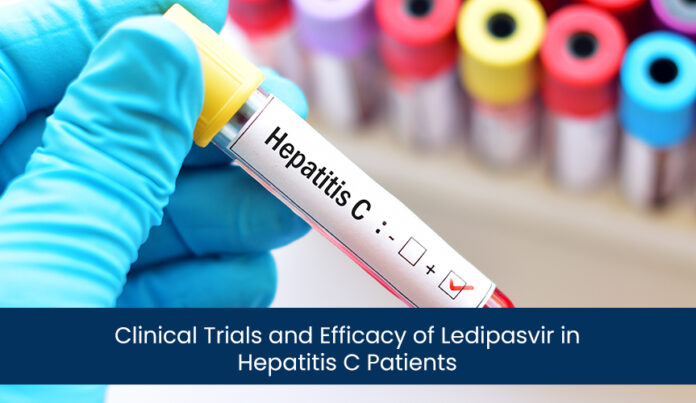Table of Contents
Introduction
Hepatitis C is a viral infection that can affect the liver, often leading to chronic liver disease and other complications. Over the years, significant advancements have been made in the Hepatitis C treatment trials, including the introduction of direct-acting antiviral (DAA) medications. One such medication is Ledipasvir, which has shown promising results in the management of Hepatitis C.
What are Ledipasvir and its mechanism of action?
Ledipasvir is a potent antiviral medication used in the treatment of Hepatitis C patient outcomes. It belongs to a class of drugs known as NS5A inhibitors. Ledipasvir is often combined with another direct-acting antiviral (DAA) medication called sofosbuvir to form a fixed-dose combination therapy known as Harvoni.
The mechanism of action of Ledipasvir involves targeting a specific protein in the Hepatitis C virus called NS5A. The NS5A protein plays a crucial role in viral replication and assembly within liver cells. By inhibiting the NS5A protein, Ledipasvir disrupts the normal functioning of the virus and prevents its ability to replicate and spread.
Ledipasvir API acts by binding to the NS5A protein, which interferes with its interaction with other viral and host proteins. This disruption leads to the inhibition of viral RNA replication, assembly of new viral particles, and release of the virus from infected cells. By blocking the NS5A protein, Ledipasvir effectively reduces the viral load in the body and helps prevent further damage to the liver.
How does Ledipasvir treat Hepatitis C?
Ledipasvir targets the NS5A protein of the Hepatitis C virus, which is essential for viral replication and assembly. By inhibiting the NS5A protein, Ledipasvir helps prevent the virus from multiplying, thereby reducing its ability to cause liver damage.
Clinical trials were conducted in order to evaluate the efficacy of Ledipasvir in Hepatitis C patients.
Many clinical trials have been done to assess the efficacy of Ledipasvir in Hepatitis C patients. These trials have demonstrated high cure rates and improved outcomes for individuals infected with Hepatitis C. In a landmark study, the ION-1 trial, Ledipasvir, and sofosbuvir combination therapy achieved sustained virologic response (SVR) rates of over 95% in both treatment-naive and treatment-experienced patients with Hepatitis C genotype one infection.
Efficacy of Ledipasvir with previous treatment options for Hepatitis C
Compared to previous treatment options for Hepatitis C, Ledipasvir has shown superior efficacy and improved tolerability. Prior to the introduction of Ledipasvir, interferon-based regimens were commonly used, but they were associated with significant side effects and lower cure rates. Ledipasvir, in combination with sofosbuvir, has revolutionized the treatment landscape by providing highly effective and well-tolerated therapy with shorter treatment durations.
The safety profile of Ledipasvir based on clinical trial data
The safety profile of Ledipasvir, based on clinical trial data, is generally favorable. Clinical trials have consistently reported that Ledipasvir is well-tolerated with minimal side effects. The most commonly reported adverse events associated with Ledipasvir include fatigue, headache, and nausea. However, these side effects are typically mild in severity and transient, meaning they resolve on their own without the need for intervention.
Serious adverse events are rare with Ledipasvir treatment. In clinical trials, the incidence of serious adverse events related to Ledipasvir was low.
Documentation and traceability are essential for producing APIs for the reasons listed below:
Compliance with standards for quality: All manufacturing processes, including information on the raw materials utilized, the equipment used, the process parameters, and the testing methods, are precisely recorded when there is thorough documentation. This documentation ensures the consistency of the product quality, makes it possible to conduct quality control studies, and makes it simpler to comply with regulatory requirements.
Product recalls and investigations: Documentation and traceability are necessary in the event of a product recall or quality issue. With the use of precise data, manufacturers may identify the source of the problem, investigate the underlying cause, and take prompt corrective action. Risks are decreased, and patient safety is maintained by doing this.
As with any medication, it is crucial for patients to communicate with their healthcare provider about any side effects or concerns they may have during Ledipasvir treatment. Healthcare providers can closely monitor patients and provide appropriate support to ensure the optimal safety and effectiveness of Ledipasvir therapy.
It is important to note that while Ledipasvir has demonstrated a favorable safety profile, individual responses may vary, and there may be rare cases of idiosyncratic reactions or hypersensitivity. Therefore, patients should always consult their healthcare provider for personalized advice and guidance regarding Ledipasvir treatment.
Ongoing research and developments related to Ledipasvir in Hepatitis C treatment
Ongoing research and developments in the field of Hepatitis C treatment continue to explore the potential of Ledipasvir. This includes investigating its use in different patient populations, such as those with advanced liver disease or co-infections with human immunodeficiency virus (HIV). Furthermore, efforts are being made to optimize treatment regimens by combining Ledipasvir with other DAA medications or exploring its use in shorter treatment durations.
Conclusion
Ledipasvir, in combination with sofosbuvir, has emerged as a highly effective and well-tolerated therapy for Hepatitis C. Clinical trials have consistently demonstrated its efficacy in achieving high cure rates and improving patient outcomes. With its favourable safety profile and minimal drug interactions, Ledipasvir has revolutionized the treatment landscape for Hepatitis C and continues to be an important component in the fight against this viral infection. Ongoing research and developments further enhance its potential in optimizing treatment strategies and expanding its use to various patient populations.


